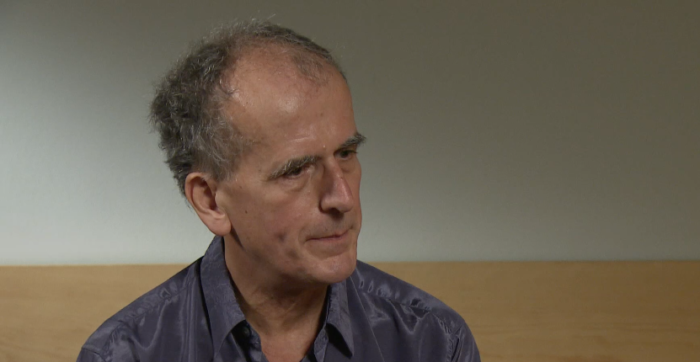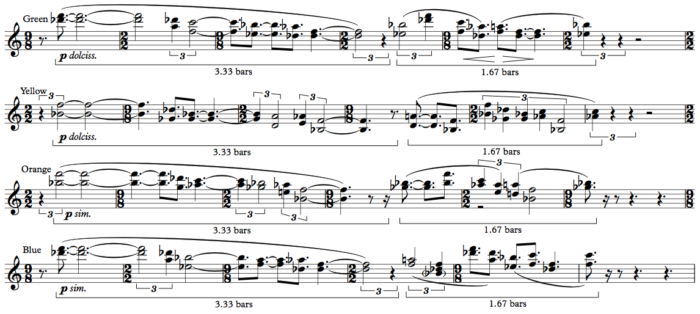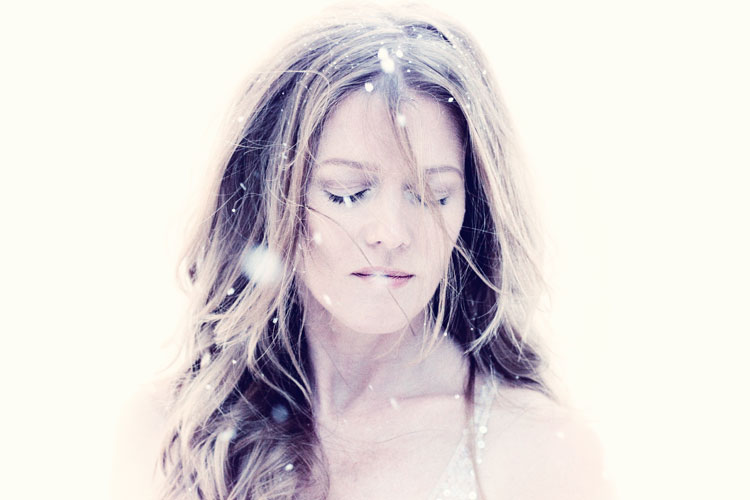This post explores Hans Abrahamsen’s use of constraint as a compositional technique in his song “let me tell you how it was.” It begins with some background on the work’s creators, briefly discussing their various literary, feminist and disability studies perspectives on constraint. It then moves into an analysis of the song’s four musical elements. While each is used with great restraint, they weave together to create a striking musical statement.
In the 1960s mathematician François Le Lionnais and poet Raymond Queneau created a society called Oulipo (Ouvroir de Littérature Potentialle) for the creation of literature within strict self-imposed constraints. For example, an author may employ the boule de neige (snowball) technique, which requires her to begin with a word that is one letter long, followed by a word that is two letters long, and so forth. Another may use the S+7 technique, a formula that replaces every noun within a work with the one found seven entries later in a dictionary.
Paul Griffiths used such constraint when writing his 2008 novel let me tell you. A music critic, librettist and writer, Griffiths decided to tell the story of Hamlet’s Ophelia using only the 483 words given to her by Shakespeare. In one interview, Griffiths discusses why he chose Ophelia for his oulipian work: “Ophelia has enough words to express herself on all sorts of matters, but also few enough that she is constantly bumping up against the unsayable.”

The year 2008 also saw the first performance of Danish composer Hans Abrahamsen’s Schnee: Ten Canons for Nine Instruments. Griffiths was deeply impressed with this work, admittedly listening to it an hour each morning during one period. The piece has thematic similarities to his aforementioned novel: Griffiths’ Ophelia wanders out into the snow at the end of his work, and Schnee translates to Snow. Griffiths described Abrahamsen’s work as “poetry of winter: of whiteness, crystal form, quietude, and expectation.”
As a composer living with cerebral palsy, Abrahamsen has an intimate understanding of creating within constraints. As a young man he took up the French horn, an instrument that requires fine motor skills in only one hand (his right hand is not fully functional). One of his early works saw him play his French horn into the strings of a piano while his friend pressed the pedals.

Two women brought these two men together creatively. The first is Anne Griffiths, the librettist’s wife. She made contact with Barbara Hannigan, hoping to do something special for her husband’s birthday. Hannigan is an internationally renowned Canadian soprano and conductor. She is shown below singing, acting and conducting Györgi Ligeti’s Mysteries of the Macabre with the GSO in black latex and heels. Ligeti himself considers Hannigan his “soprano of choice.”
It was Anne Griffiths who suggested Hans Abrahamsen’s name, and Hannigan who secured a commission from the Berlin Philharmonic Orchestra with funding from the Danish Arts Council. Hannigan also helped Abrahamsen for a few months during the composition process. The composer had never written a major vocal work, and Hannigan sang him many examples and instructed him on vocal composition. In 2013, Abrahamsen’s completed song cycle was debuted by Hannigan and the BPO to critical acclaim. It has since won numerous awards, including the 2016 Grawemeyer Award. Hannigan eloquently described her experience performing the composition in one interview:
I’m playing Ophelia today, looking back at what happened however many years ago, when Shakespeare wrote the play, when Shakespeare gave her those words to play… five hundred years ago? Something like that? So she has witnessed time. She has witnessed, you know, the witch hunts, and feminism, and you know, different women in history. She has witnessed the change of what a woman is allowed to be or say over time. So of course I feel that.

Even within the first song of the cycle, “let me tell you how it was,” it becomes clear that Abrahamsen represents Griffiths’ oulipian text through musical constraint. The piece is broken into two 24-bar sections, and Abrahamsen uses only four compositional components throughout this opening song. Table 1 is colour-coded (with bar numbers on both the top and bottom lines) to show how these components are used throughout the piece: the four similar but contrasting wind/string theme variants appear in green, yellow, orange and blue; the low wind/brass accompaniment is shown in plum; the soprano melody is in lighter shades of blue and yellow, demonstrating its relatedness to the wind/string theme; and the ostinato rhythm/pedal point is shown in mauve. Notice the clear instrumental transition that takes place between the piece’s first and second sections.

1. The wind/string theme
The piece develops a theme first presented in Schnee’s “Canon 1B,” using the four repeating variants shown in Figure 1.

These variants, first heard in the wind instruments and later in the string section, are similar in many ways. First, they are all asymmetrical periods of five bars broken into one 3.33 bar phrase and one 1.67 bar phrase. Second, the four variants share six different pitches (Bb, C, Db, F, Ab and A). Third, the inter-onset intervals (IOIs) become shorter during each iterated period.
There are also differences within these variants. First, each orange and blue iteration use a symmetrical nine note scale (Bb, C, Db, D, E, F, Gb, Ab, A) while the green and yellow ones only use the six aforementioned notes. Second, while the yellow/orange and green/blue variant pairs are rhythmically similar, there are some slight differences: the orange has a slightly longer initial IOI than the yellow, and there is rhythmic variation in the fifth bar of both the green and blue.
At least one of these four variants are found in every bar of the cycle’s first song, and each is repeated three times (though the order changes slightly). Whenever more than one occurs at the same time, blue always overlaps orange while green overlaps yellow. All of the theme’s occurrences are shown in Table 2 below.

2. The low wind/brass accompaniment
The theme above occurs in another way later in the piece, albeit in a harmonic and rhythmic disguise. Figure 2 shows the low wind/brass accompaniment that occurs during the piece’s climax:

Notice that, reminiscent of the theme above, there are two asymmetrical periods in this accompaniment, a longer phrase followed by a shorter one. The similarities do not end there; in fact, this accompaniment is derived directly from the wind/string theme. The intervals of the green variant melody are reversed and transposed to become the bottom note of the low wind/brass accompaniment’s first period. The upper notes in the low wind/brass accompaniment move in parallel motion to the bottom note and aren’t related to the bottom note in the green variant. These relationships are shown in Table 3.

Similarly, the second period of the low wind/brass accompaniment reverses the interval relationships found in the blue variant. In this instance, the upper notes maintain the same intervallic relationships between the top and bottom notes in the blue variant. In Table 4, the second line from the bottom (with the blue background) represents the harmonic intervals found in the blue variant of the wind/string theme. The bottom line shows the harmonic intervals in the second period of the low wind/brass accompaniment.

3. The soprano melody
The soprano melody is also similar to the wind/string theme, containing two asymmetrical periods. In contrast to the wind/string theme, a phrase 1.89 bars long is followed by one 3.22 bars long. There is further contrast when one considers the IOIs in the soprano melody, which get longer as you move toward the end of each period. These differences in phrase and IOI lengths avoid masking the melody with other instruments in a similar range. The soprano periods use two alternating scales, Bb whole tone and Db whole tone. Those using the Db whole tone scale correspond with the green/yellow variants of the wind/string theme, and those using the Bb whole tone scale correspond with the blue/orange variants. Having access to only the six melodic intervals available within the whole tone scale, Abrahamsen restricts certain intervals to specific functions. Minor sevenths, for instance, are only used to conclude periods or sections of the melody. Figure 3 shows the first period of the soprano melody.

4. The ostinato rhythm/pedal point
Along with the wind/string theme, the low wind/brass accompaniment and the soprano melody, there is a final anchoring component Abrahamsen uses in the first song of his cycle. It is an ostinato rhythm/pedal point which, like the wind/string theme, is found in each of the piece’s 48 bars. This component appears in the strings and celesta in the first 24 bars and is taken over by the wind instruments, vibraphone, marimba and harp in the second 24 bar section. This corresponds to a switch in the wind/string theme’s instrumentation, which begins in the wind section and ends in the strings. Figure 4 shows the first five bars of the ostinato rhythm/pedal point (like the wind/string theme and soprano melody before it, this component also occurs in five bar phrases).

5. Conclusions
Abrahamsen himself has called his song cycle “very constructed.” By briefly examining the four compositional components he uses in the first song, it becomes clear just how true that statement is. First, the wind/string theme was taken from one of Abrahamsen’s earlier works and also occurs in every bar of the piece. It has been turned into four variants of identical length, and Abrahamsen repeats each of these variants the same number of times. Moreover, only green and yellow or blue and orange occur together when iterations of these variants overlap. Second, every note of the low brass/wind accompaniment is a precise inversion of a wind/string theme variant lasting about seven bars. Third, the soprano melody he creates is highly repetitive, broken into periods and phrases of the same length (with two exceptions occurring in similar spots), and uses only six intervals. Additionally, the light yellow and blue periods/phrases of this melody always occur with their matching wind/string variants. Finally, the pedal point/ostinato rhythm occurs in every bar of the piece and uses similar alternating phrases throughout. As a further constraint, Abrahamsen only shifts the orchestration of these elements in one spot, the beginning of the piece’s second section.
“Let me tell you how it was” introduces Ophelia, who tries to muster up the courage to tell her story. Abrahamsen highlights her inner conflict with an unconventional melody, harmonic dissonance, and rhythmic intricacy. Yet all of this complexity was created within remarkable self-imposed constraints, reminiscent of the character’s own temporal limitations. In this way, Abrahamsen has created a fitting homage to Paul Griffiths’ character. One might say that through the medium of music, Abrahamsen is able to say what Griffiths can only bump up against.

2 replies on “Saying the Unsayable in Hans Abrahamsen’s “let me tell you how it was””
Hi
Just wanted to clarify:
Hans Abrahamsen is danish not dutch.
He was born and raised in Copenhagen.
Thanks!